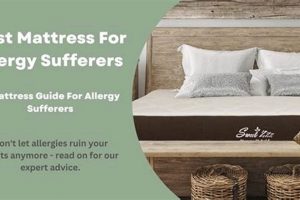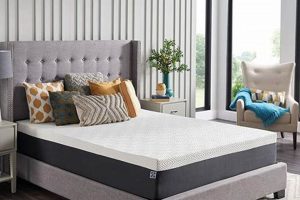The selection of a superior flotation sleep system involves several key considerations. These sleeping platforms utilize water as the primary support structure, offering a unique conforming characteristic unlike traditional innerspring or foam counterparts. The selection process necessitates evaluating factors such as bladder type (single or dual), wave reduction technology, and material durability.
These systems were initially favored for their even weight distribution, potentially alleviating pressure points and promoting improved circulation. Historically, these beds gained popularity due to their adaptability and personalized comfort levels. While the market share has shifted with the advent of new mattress technologies, they remain a viable option for individuals seeking a distinct sleep experience.
A comprehensive assessment of these systems should therefore encompass an analysis of different types, their respective advantages and disadvantages, key features contributing to user satisfaction, and maintenance requirements for ensuring longevity. Subsequent sections will delve into specific aspects crucial for informed decision-making.
Guidance on Flotation Sleep System Selection
The selection of a suitable flotation sleep system necessitates careful consideration of multiple factors to ensure optimal sleep quality and long-term satisfaction.
Tip 1: Evaluate Bladder Configuration: Determine whether a single or dual bladder system is more appropriate. Dual bladder systems allow for individualized firmness adjustments on each side, accommodating differing sleep preferences within a shared bed.
Tip 2: Assess Wave Reduction Technology: Understand the different levels of wave reduction available, ranging from free-flow to fully waveless. Higher wave reduction minimizes motion transfer and provides a more stable sleep surface.
Tip 3: Examine Material Durability: Inspect the construction material of the mattress bladder. Higher-quality vinyl or reinforced materials offer greater resistance to punctures and leaks, extending the lifespan of the sleep system.
Tip 4: Consider Heating System Features: If a heated system is desired, research the efficiency and safety features of available heaters. Look for models with adjustable temperature settings and automatic shut-off mechanisms.
Tip 5: Factor in Frame Compatibility: Ensure that the chosen mattress is compatible with the existing or intended bed frame. Proper frame support is crucial for maintaining the integrity and shape of the flotation sleep system.
Tip 6: Investigate Warranty Coverage: Review the manufacturer’s warranty terms and conditions. A comprehensive warranty provides assurance against defects in materials or workmanship.
Tip 7: Research Maintenance Requirements: Familiarize oneself with the maintenance procedures necessary for maintaining the mattress. Regular water conditioning and leak detection are essential for long-term performance.
Adhering to these guidelines facilitates a more informed decision, potentially leading to enhanced comfort and a prolonged lifespan of the chosen system.
The following section will address specific considerations regarding maintenance and long-term care for optimal performance and longevity.
1. Wave Reduction
Wave reduction technology is a crucial determinant of sleep quality in flotation sleep systems. The degree to which a mattress minimizes wave motion directly impacts sleep disturbance and overall comfort. The implementation of wave reduction features distinguishes a basic flotation bed from a higher-quality, more sleep-conducive system.
- Fiber Batting Density
Higher-density fiber batting within the mattress bladder effectively dampens wave motion. Increased fiber content translates to quicker stabilization after movement, minimizing ripple effects that can disrupt sleep. Reduced motion transfer benefits both the sleeper and any partner sharing the bed.
- Baffle Systems
Internal baffle systems, strategically placed within the bladder, compartmentalize the water volume. These baffles restrict water flow, thereby limiting the propagation of waves. The effectiveness of baffle systems is often dependent on the number and configuration of the internal partitions.
- Mattress Depth and Water Volume
Mattress depth, and consequently the water volume, influences the amplitude and frequency of waves. Shallower mattresses generally exhibit less wave motion compared to deeper mattresses with greater water capacity. Balancing depth with support is a key design consideration.
- Anchoring Systems
Some advanced models incorporate anchoring systems that tether the internal components to the mattress frame or base. This added stability further reduces wave motion and prevents excessive shifting of internal components, maintaining a more consistent sleep surface.
The integration of effective wave reduction technologies is paramount in creating a superior flotation sleep experience. The combination of fiber batting, baffle systems, optimized depth, and anchoring mechanisms contributes significantly to minimizing sleep disturbance and enhancing overall comfort, positioning a system as a top contender in its class. These features contribute significantly to minimizing sleep disturbance and enhancing overall comfort.
2. Material Quality
Material quality exerts a profound influence on the performance and longevity of flotation sleep systems. The composition and construction of the bladder, seams, and other components directly impact resistance to punctures, leaks, and degradation, thereby affecting the overall lifespan and user satisfaction with the product.
- Vinyl Composition and Thickness
The type and thickness of the vinyl used in the mattress bladder are critical. Higher-grade vinyl formulations exhibit greater resistance to stretching, tearing, and chemical degradation from water conditioners. Increased thickness provides enhanced puncture resistance, minimizing the risk of leaks. The optimal balance between flexibility and durability is achieved through careful selection of vinyl characteristics.
- Seam Construction Techniques
The method of seam construction significantly affects the structural integrity of the bladder. Reinforced seams, utilizing radio frequency (RF) welding or similar techniques, create stronger, more durable bonds that withstand the constant pressure exerted by the water. Weak or poorly constructed seams are prone to failure, leading to leaks and diminished mattress performance.
- Reinforcement Layers and Fabrics
The inclusion of internal reinforcement layers, such as nylon or polyester fabrics, provides added stre
ngth and dimensional stability to the mattress bladder. These layers help distribute stress and prevent localized stretching or bulging, prolonging the lifespan of the system. The quality and density of the reinforcement fabric are directly proportional to the overall durability of the mattress. - Component Compatibility and Adhesives
The compatibility of all materials used in the construction, including adhesives, baffles, and connectors, is essential. Incompatible materials can react with each other over time, leading to degradation and potential failures. The use of high-quality, non-reactive adhesives ensures that all components remain securely bonded, maintaining the integrity of the flotation system.
Therefore, scrutinizing material quality is a crucial step in identifying a superior flotation sleep system. Robust construction, utilizing high-grade vinyl, reinforced seams, and compatible components, contributes directly to the durability, reliability, and overall value proposition. Systems employing substandard materials are inherently more susceptible to failure, negating any potential cost savings in the long term. A careful assessment of these features is therefore paramount in ensuring a lasting and satisfactory ownership experience.
3. Temperature Control
Temperature control is an integral element in the functionality and user satisfaction of flotation sleep systems. The ability to regulate the temperature of the water within the mattress directly influences comfort levels and can provide therapeutic benefits. Flotation systems often incorporate heating elements and thermostats to allow users to adjust the sleeping surface to a desired temperature. The efficacy and safety of these temperature control systems are therefore critical considerations in evaluating a quality flotation bed.
Precise temperature regulation can promote muscle relaxation and alleviate pain associated with certain conditions, such as arthritis or fibromyalgia. The consistent application of gentle warmth can improve circulation and reduce stiffness, leading to a more restful sleep. Conversely, inadequate or unreliable temperature control can result in discomfort, sleep disruption, and potential safety hazards, such as overheating or electrical malfunctions. The capacity to maintain a stable and safe temperature is a key differentiator between entry-level and superior systems. Real-world examples highlight the importance of this feature, with users reporting enhanced sleep quality and pain reduction attributed to consistent temperature control. Systems that allow for gradual temperature adjustment and feature built-in safety mechanisms are generally preferred.
In summary, temperature control represents a significant factor in the overall effectiveness and appeal of flotation sleep systems. The ability to provide consistent, adjustable, and safe heating contributes substantially to user comfort and therapeutic benefits. Challenges remain in ensuring energy efficiency and preventing potential malfunctions, but ongoing advancements in heating technology continue to improve the reliability and safety of these systems. The integration of robust and user-friendly temperature control further solidifies a waterbed’s position as a premium sleep solution.
4. Lumbar Support
Lumbar support is a critical consideration in the context of flotation sleep systems. The inherent properties of water displacement necessitate careful design to ensure adequate support for the lumbar region of the spine, influencing spinal alignment and overall sleep comfort.
- Internal Baffle Design and Placement
The configuration of internal baffles within the water bladder plays a significant role in providing targeted lumbar support. Strategic placement of baffles can create zones of increased firmness in the lumbar region, preventing excessive sinking and maintaining proper spinal curvature. Insufficient baffle support can result in spinal misalignment and lower back discomfort.
- Fiber Density and Distribution
The density and distribution of fiber materials within the mattress bladder contribute to the overall support characteristics. Higher fiber density in the lumbar region offers increased resistance to compression, providing enhanced support. Uneven distribution can lead to inconsistent support and localized pressure points.
- Mattress Depth and Water Displacement Dynamics
The depth of the mattress and the associated water displacement dynamics influence the level of lumbar support. Deeper mattresses may require more sophisticated internal support systems to prevent excessive sinking. The interaction between body weight and water displacement must be carefully calibrated to achieve optimal lumbar alignment.
- Integration with External Support Structures
Some flotation systems incorporate external support structures, such as foam bolsters or adjustable lumbar support inserts, to further enhance lumbar support. These external elements can be used to fine-tune the support level and accommodate individual needs. Compatibility with these external support structures is an important consideration in evaluating a flotation sleep system.
The adequacy of lumbar support in a flotation sleep system is paramount for promoting spinal health and maximizing sleep comfort. A well-designed system will incorporate internal and potentially external features to ensure proper lumbar alignment, thereby mitigating the risk of back pain and promoting restful sleep. A holistic approach to design and construction ensures that this aspect is fully addressed for a better sleep.
5. Frame Compatibility
Frame compatibility is a foundational aspect of any successful flotation sleep system installation. The structural integrity and longevity of a waterbed are directly contingent upon proper support provided by the surrounding frame. Selection of an appropriate frame is therefore paramount to ensure optimal performance and prevent potential damage or failure of the mattress.
- Weight Distribution Capacity
A waterbed, when filled, exerts significant weight distributed across the frame. The frame must possess sufficient structural capacity to bear this load without deformation or collapse. Insufficient weight distribution capacity can lead to frame warping, joint failure, and ultimately, compromise the integrity of the sleep system. Adequate reinforcement and robust construction are essential to prevent such scenarios. For example, a queen-size waterbed can weigh upwards of 1600 pounds, requiring a frame specifically engineered to handle this magnitude of sustained weight.
- Dimensional Accuracy and Fit
Precise dimensional matching between the mattress and the frame is critical to prevent undue stress on the mattress seams and corners. A frame that is too small will compress the mattress, increasing the risk of seam failure. Conversely, an oversized frame will allow the mattress to sag, compromising support and comfort. Accurate measurements and proper fitting are essential for optimal mattress performance. For instance, a tight f
it concentrates pressure points, reducing overall durability. - Material Compatibility and Chemical Interactions
The frame material must be chemically compatible with the vinyl used in the water mattress. Certain wood treatments, paints, or coatings can react with the vinyl, causing degradation or discoloration. Careful consideration of material compatibility is necessary to prevent premature mattress failure and maintain its aesthetic appeal. For instance, some oil-based finishes can soften or degrade vinyl over prolonged contact.
- Edge Support and Containment
The frame should provide adequate edge support to prevent the mattress from bulging or shifting. Robust edge support is particularly important for individuals who sleep near the edge of the bed. Inadequate edge support can lead to discomfort and potential mattress damage. A frame with sturdy side rails and corner reinforcements provides the necessary containment to maintain mattress shape and stability. For instance, a weak frame might bow outwards, leaving the sleeper with a sense of instability.
In conclusion, frame compatibility is not merely an aesthetic consideration, but a fundamental requirement for the proper functioning and longevity of any flotation sleep system. Selection of a frame with appropriate weight distribution capacity, dimensional accuracy, material compatibility, and edge support is essential for maximizing comfort, preventing damage, and ensuring the overall satisfaction with the bed.
Frequently Asked Questions
The following addresses common inquiries and misconceptions regarding flotation sleep systems, aiming to provide clarity and informed perspectives.
Question 1: What constitutes the primary advantage of a flotation sleep system over traditional innerspring mattresses?
The primary advantage lies in its contouring capabilities, offering uniform support across the body. This reduces pressure points and enhances circulation compared to the localized support offered by innerspring systems.
Question 2: Are flotation mattresses prone to leaks, and what measures can be taken to mitigate this risk?
While punctures are a potential concern, modern designs employ durable vinyl and reinforced seams. Routine inspection for sharp objects and the use of a protective mattress pad can minimize the likelihood of leaks.
Question 3: How is wave motion managed in contemporary flotation systems, and what impact does this have on sleep quality?
Wave motion is minimized through internal baffle systems and fiber batting. These features reduce motion transfer, promoting a more stable and undisturbed sleep environment.
Question 4: What are the key maintenance requirements for ensuring the longevity of a flotation mattress?
Maintenance includes regular addition of water conditioner to inhibit bacterial growth and prevent vinyl degradation. Periodic inspection for leaks and proper frame support are also essential.
Question 5: Is temperature control a standard feature in most flotation sleep systems, and how does it contribute to user comfort?
While not universal, temperature control is a common feature. Integrated heating elements allow for adjustable warmth, enhancing comfort and promoting muscle relaxation.
Question 6: Do flotation mattresses accommodate varying body weights and sleep preferences, and how is this achieved?
Flotation systems offer adaptability through adjustable water volume and bladder configurations. Dual bladder systems allow for individualized firmness on each side of the bed.
In summary, while certain concerns exist regarding maintenance and potential leaks, modern flotation systems offer unique benefits in terms of pressure relief, adjustability, and temperature control when properly maintained.
The subsequent section will examine the market landscape, exploring the availability of these systems and their comparative advantages in relation to contemporary sleep technologies.
In Summary
The foregoing examination has illuminated the critical factors involved in discerning a superior flotation sleep system. Key considerations encompass wave reduction capabilities, material quality, temperature control efficacy, lumbar support provision, and frame compatibility. Each element contributes to the overall performance, longevity, and ultimately, user satisfaction. Neglecting any of these factors increases the risk of selecting a suboptimal system with compromised support or reduced lifespan.
Therefore, a comprehensive understanding of these attributes is paramount for informed decision-making. The prospective purchaser is encouraged to carefully evaluate systems against these criteria to ensure a sleep solution that aligns with individual needs and preferences. The investment in thorough research will yield a sleep experience that is both comfortable and enduring.




![Top-Rated Best Futon Mattress [Guide] Comfort & Value Organic & Natural Mattress Buyer’s Guide: Non-Toxic Sleep Solutions Top-Rated Best Futon Mattress [Guide] Comfort & Value | Organic & Natural Mattress Buyer’s Guide: Non-Toxic Sleep Solutions](https://mattressworldpa.com/wp-content/uploads/2025/07/th-7685-300x200.jpg)


![Top-Rated Best Split King Adjustable Mattress [Guide] Organic & Natural Mattress Buyer’s Guide: Non-Toxic Sleep Solutions Top-Rated Best Split King Adjustable Mattress [Guide] | Organic & Natural Mattress Buyer’s Guide: Non-Toxic Sleep Solutions](https://mattressworldpa.com/wp-content/uploads/2025/07/th-7682-300x200.jpg)